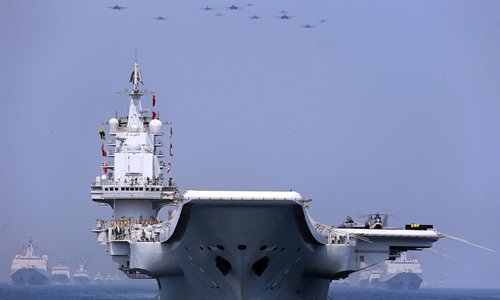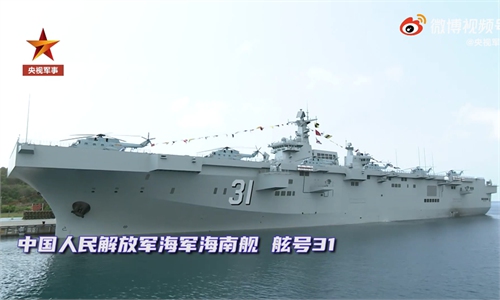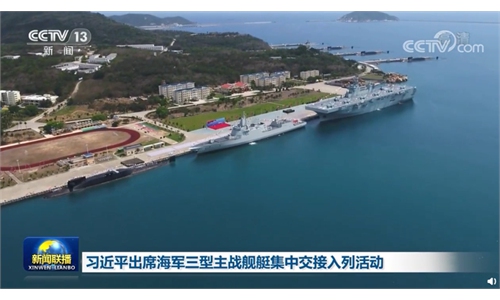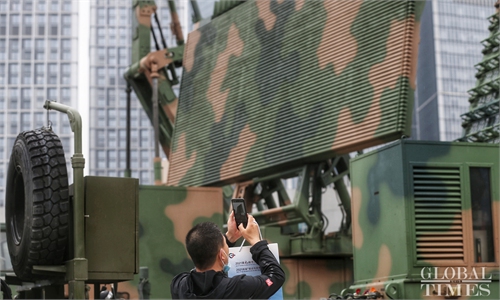China's Liaoning aircraft carrier group crosses Miyako Strait, patrols Diaoyu Islands, 'warning to Japan'

The picture shows the aircraft carrier Liaoning (Hull 16) and other vessels and fighter jets in the maritime parade conducted by the Chinese People's Liberation Army (PLA) Navy in the South China Sea on the morning of April 12, 2018. Chinese President Xi Jinping, who is also general secretary of the Communist Party of China (CPC) Central Committee and chairman of the Central Military Commission (CMC), reviewed the parade. (eng.chinamil.com.cn/Photo by Zhang Lei)
The Liaoning aircraft carrier task group of the Chinese People's Liberation Army (PLA) Navy reportedly crossed the Miyako Strait again on Monday and sent an aircraft near the Diaoyu Islands on Tuesday, which Chinese experts said sends a warning to Japan amid the country's recent, repeated wrong statements on China's Diaoyu Islands. Similar PLA activities will likely become routine depending on China-Japan relations, experts said.
The Japan Maritime Self-Defense Force spotted a PLA Navy flotilla consisting of six warships, namely the aircraft carrier Liaoning, the Type 055 large destroyer Nanchang, the Type 052D destroyers Chengdu and Taiyuan, the Type 054A frigate Huanggang and the Type 901 comprehensive supply ship Hulunhu, which passed through waters between Okinawa Island and Miyako Island and sailed north toward the East China Sea on Monday, Japan's Ministry of Defense Joint Staff said in a press release on Wednesday.
On April 3, the same flotilla went south from the same region, the statement said, indicating that the Chinese carrier group was returning to where it came from.
Also, a Z-18 early warning helicopter from the Liaoning approached the Chiwei Islet of the Diaoyu Islands on Tuesday, according to the Japanese statement.
Chinese military observers said it was predictable that the task group would return from its exercises near the island of Taiwan and in the South China Sea via the Miyako Strait, but it is rare to see that the carrier group sent aircraft near the Diaoyu Islands.
The Liaoning aircraft carrier group's recent movements serve as a warning and deterrent to Japan, Xu Guangyu, senior advisor to the China Arms Control and Disarmament Association, told the Global Times on Wednesday.
Japan has been repeatedly making wrong statements on the Diaoyu Islands, including having the US reaffirm the coverage of the islands in its defense commitment to Japan in early April, and criticizing the China Coast Guard vessels' legal and rightful patrol and law enforcement activities in waters off Chinese islands in a diplomatic bluebook released on Tuesday.
The PLA will likely hold similar operations and make them regular, based on the development of China-Japan relations, until related questions are solved, Xu said.
Japan's report on the Liaoning's recent activities also smashed rumors recently spread by some Taiwan media claiming the carrier "lost its power," analysts said.
Citing commercial satellite imagery, reports on Tuesday by Taiwan media again said some US warships recently stalked the PLA carrier group, but Chinese mainland experts said the satellite images are out of context, and it is common for warships and warplanes from different countries to monitor each other in international waters, as long as they abide by international regulations to prevent collisions, keep a safe distance and avoid other accidents.
The PLA Navy announced on April 5 that the Liaoning aircraft carrier task group was conducting exercises near the island of Taiwan at that time as part of annually scheduled regular training. Later reports indicate that the carrier group went further south into the South China Sea for additional exercises.




